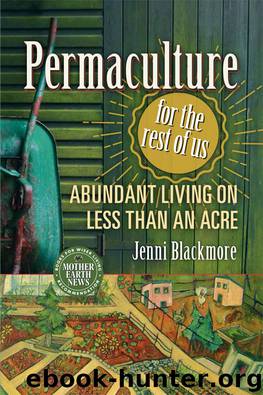Permaculture for the Rest of Us: Abundant Living on Less than an Acre by Jenni Blackmore

Author:Jenni Blackmore [Blackmore, Jenni]
Language: eng
Format: azw3, epub
ISBN: 9781550926071
Publisher: New Society Publishers
Published: 2015-10-12T04:00:00+00:00
Snow peas (named to indicate just how soon they like to be planted) and snap peas are both wonderfully tender and sweet and have edible, truly edible, pods. They are used in stir-fries and salads but don’t produce a prodigious crop of full sized peas, the type used for drying and split pea soup. Later varieties are a much better choice for this purpose. Peas are quite susceptible to a withering dry mold. Once this appears it is best to pull out all the vines and burn them to prevent the spread of this fungus. As it can linger in the soil several years, it is especially important to rotate pea plantings around various locations. A tincture of Horsetail (the weed not the animal) is said to be effective as a preventative but this does require a diligent and regular spraying program that needs to be instituted at the very first signs of dry mold.
Beans like much warmer soil and will rot in the ground if the soil feels too cold. They germinate quickly and produce much sturdier shoots than peas, which is no doubt why they are often used in elementary school science projects. Other than the obvious, there are several differences between bush and runner beans. The bush type are often referred to as “snap” beans because their tender pods are crisp and will snap easily when picked early. They can be eaten raw in salads, cooked in stir-fries or served simply as a vegetable side dish. When left on the vine the pods will gradually toughen up and dry, producing beans for soup, baking or the next year’s garden. There are several all-purpose beans and equally as many that are better suited for either drying or eating fresh. The “soup” beans I planted this year were disappointing as green beans but have supplied a beautiful crop of pure white beans that tumble out of their pods as though they just couldn’t wait to get out.
Some runner beans, when picked young enough, will seem quite similar to bush beans but others, such as Scarlet Runners, have a more substantial pod containing larger, flatter beans. These are the beans usually cut diagonally and served or frozen as “French cut” beans. I would argue that they are more vigorous plants, provide great shade canopies and have a better flavour than other pole type beans. It is undeniable that hummingbirds love their bright red flowers, so they are certainly worth planting, if only for that one reason.
Broad beans are another kettle of legumes altogether. They like to be planted very early (some varieties in the preceding fall) and are quite slow to grow. Instead of hanging off a graceful vine the overlarge pods sprout upwards off a rugged stem and in truth, the whole plant looks somewhat ungainly. These plants definitely need to be planted within a substantial framework as they tend to become too heavy to support themselves. A typical garden stake won’t do. The unique taste of these beans
Download
Permaculture for the Rest of Us: Abundant Living on Less than an Acre by Jenni Blackmore.epub
This site does not store any files on its server. We only index and link to content provided by other sites. Please contact the content providers to delete copyright contents if any and email us, we'll remove relevant links or contents immediately.
Turbulence by E. J. Noyes(7936)
The Thirst by Nesbo Jo(6828)
Gerald's Game by Stephen King(4583)
Be in a Treehouse by Pete Nelson(3948)
Marijuana Grower's Handbook by Ed Rosenthal(3623)
The Sprouting Book by Ann Wigmore(3543)
The Red Files by Lee Winter(3368)
The Remains of the Day by Kazuo Ishiguro(3293)
Sharp Objects: A Novel by Gillian Flynn(2956)
Christian (The Protectors Book 1) by L. Ann Marie(2654)
Organic Mushroom Farming and Mycoremediation by Tradd Cotter(2626)
The Culinary Herbal by Susan Belsinger(2431)
Stone Building by Kevin Gardner(2350)
The Starter Garden Handbook by Alice Mary Alvrez(2282)
Lilac Girls by Martha Hall Kelly(2258)
The Unlikely Pilgrimage of Harold Fry by Rachel Joyce(2220)
The Lean Farm Guide to Growing Vegetables: More In-Depth Lean Techniques for Efficient Organic Production by Ben Hartman(2096)
Urban Farming by Thomas Fox(2061)
Backyard Woodland by Josh VanBrakle(1895)
